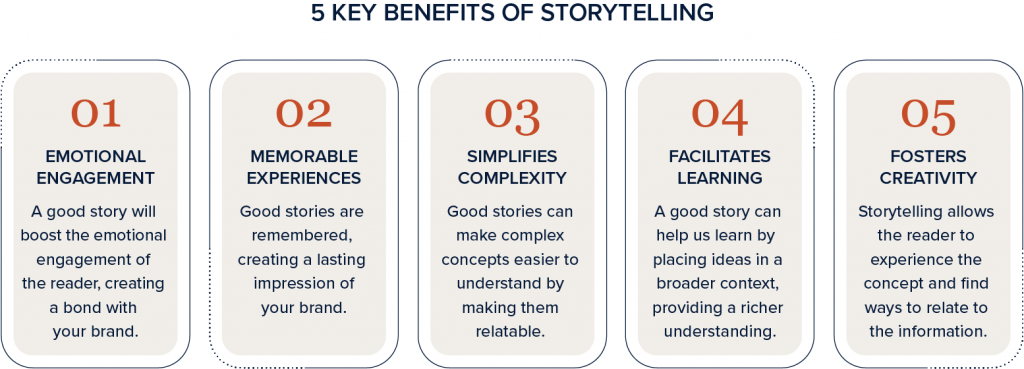The Art of Storytelling in CGT Marketing.
By Gianna Troppy

Storytelling has been a fundamental part of human communication since the beginning of time, serving as a cornerstone for sharing knowledge, preserving history, and fostering connections. Our innate affinity for stories enables us to absorb information, relate to experiences, and make sense of the world around us. In our modern, information-rich world, the art of storytelling remains as important as ever. Stories resonate with us emotionally, guiding our perceptions and influencing our daily decisions.
For marketers, storytelling goes beyond conventional marketing, and it is one of the most powerful tools to captivate audiences and make a lasting impact, particularly in the science and technology sector, where it is easy to get lost in data and highly technical jargon. Instead of simply conveying information, storytelling can evoke emotions, inspire action, and unite stakeholders. When done correctly, it can bring your brand to life, making it relatable and authentic, so it resonates with audiences in a way that can help you stand out from the competition. Crafting compelling narratives that convey your brand’s “why,” values, and mission, can help establish a unique voice and personality that not only humanizes your brand but builds emotional connections and trust with your target audience.
Why Storytelling Matters in CGT Marketing
Within the rapidly evolving landscape of cell and gene therapy (CGT), stakeholders are inundated with a constant stream of new data and technologies, making it challenging to cut through the noise and convey information in a captivating (rather than transactional) way. CGT stakeholders are driven by a common goal: to improve patient outcomes and positively impact lives with groundbreaking treatments. It can be easy to forget the human element that underpins the science.
A well-crafted, easy-to-follow narrative can effectively communicate complex scientific concepts with more impact than facts or figures could accomplish alone.
A well-crafted, easy-to-follow narrative can effectively communicate complex scientific concepts with more impact than facts or figures could accomplish alone. By tapping into human emotions and experiences, stories enable audiences to connect on a personal and emotional level that fosters trust in the message being conveyed. By leveraging storytelling techniques like narrative structure, developing relatable characters, and using visual aids, one can transform scientifically dense content into engaging narratives that are accessible and relatable to a broad audience.

Storytelling also serves as a valuable tool for navigating polarizing topics in a format that is easily digestible, which is beneficial in a field where misconceptions, ethical dilemmas, and regulatory complexities are commonplace. Leading with authenticity, vulnerability, and empathy allows brands to connect with audiences on a human level beyond the scientific and technical aspects. By acknowledging the hopes, fears, and aspirations of patients, storytelling builds trust and confidence in the transformative potential of these innovative therapies.
Leveraging Personalization and Human Connection
A compelling story draws audiences in, giving them something or someone to care deeply about from the outset. Many companies in the CGT field utilize patient stories to convey the impact of their treatments. These stories resonate with a wide audience, from patients and scientists to investors and policymakers. They provide hope to individuals and families affected by various health challenges and contribute to raising awareness and acceptance of innovative treatment modalities. This in turn catalyzed increased funding allocations aimed at supporting research into CAR-T and similar groundbreaking treatments, marking a turning point for the field.
In the competitive arena of CGT, effective branding must be more than just logos and products. It requires creating a unique identity that establishes a strong and recognizable presence in the market, communicates a brand’s values and beliefs, and cultivates trust and loyalty among stakeholders. By leveraging narratives that resonate personally, and using relatable characters and experiences, brands can create deep connections with their target audience to build relationships, shape perceptions, and increase engagement. Highlighting the human connection to groundbreaking therapeutics, we witnessed firsthand how prioritizing this connection positively impacted public perception, bolstered patient engagement, and galvanized public support for CAR-T cell therapies that ultimately benefited the CGT field as a whole.
Using storytelling effectively in CGT marketing is a nuanced art, requiring a delicate balance of science, empathy, and creativity to make the complex compelling.
Using storytelling effectively in CGT marketing is a nuanced art, requiring a delicate balance of science, empathy, and creativity to make the complex compelling. Not every firm can master this art, but at Orange County Bio, we excel in delivering innovative storytelling solutions that resonate deeply with audiences, driving brand awareness, loyalty, and trust. Our tailored approach ensures that each client receives personalized strategies designed to maximize impact and achieve their unique goals. Through our track record of success and proven expertise, we have helped numerous clients witness increased engagement and ROI. With Orange County Bio as your trusted CGT marketing partner, we can help you differentiate your brand and captivate stakeholders to establish a strong foothold in an increasingly crowded marketplace.
Contact us today to discover how we can bring your CGT innovations to life: info@orangecountybio.com.
